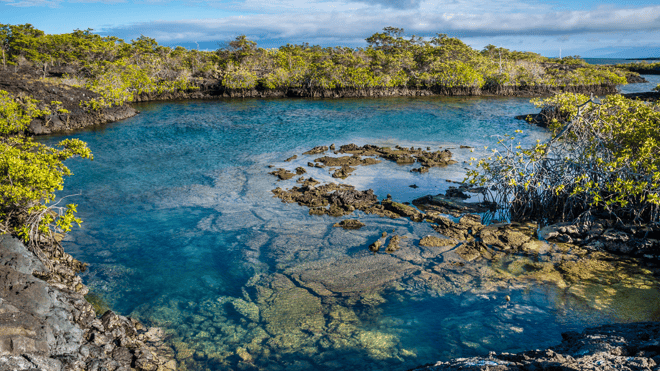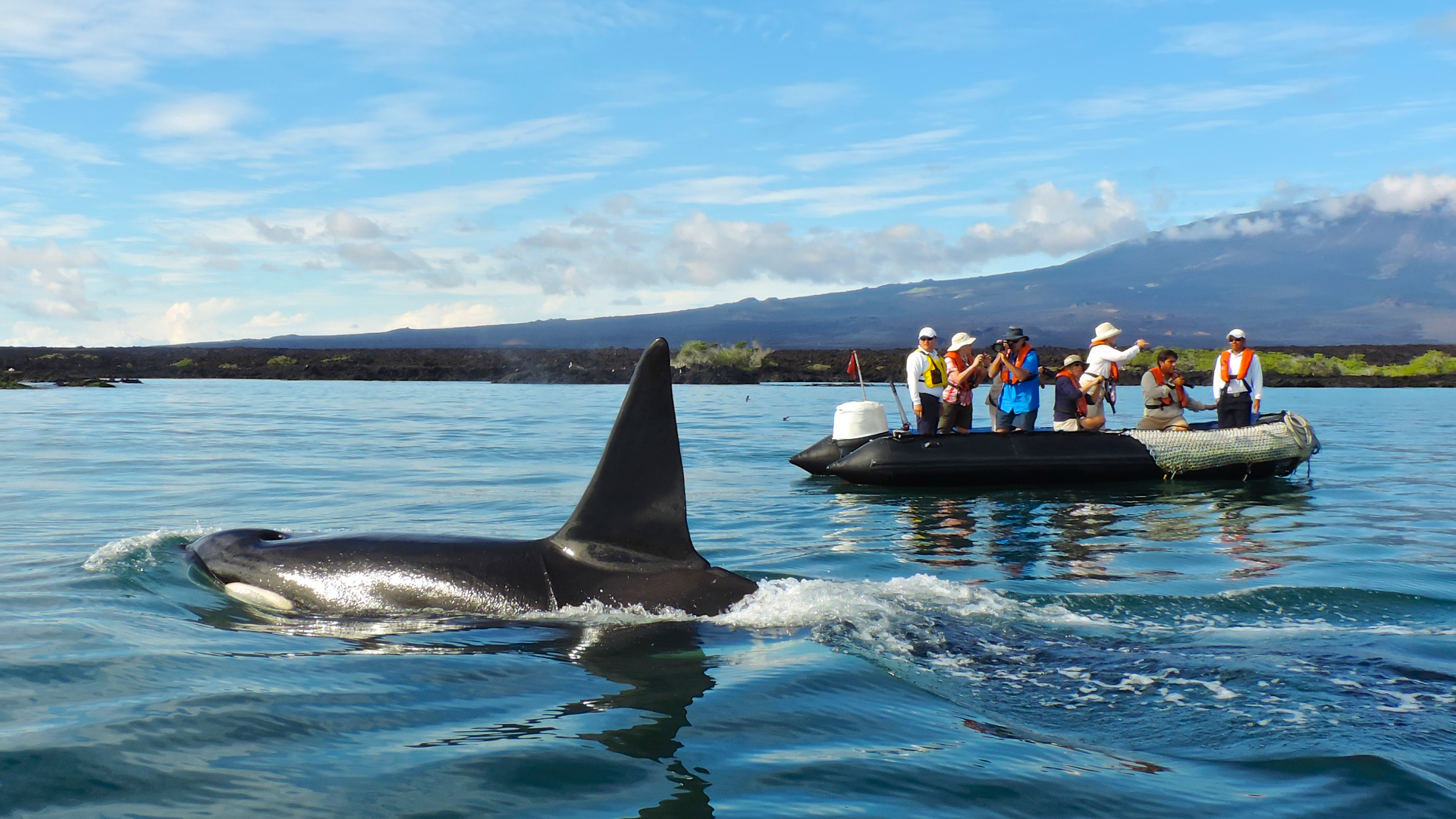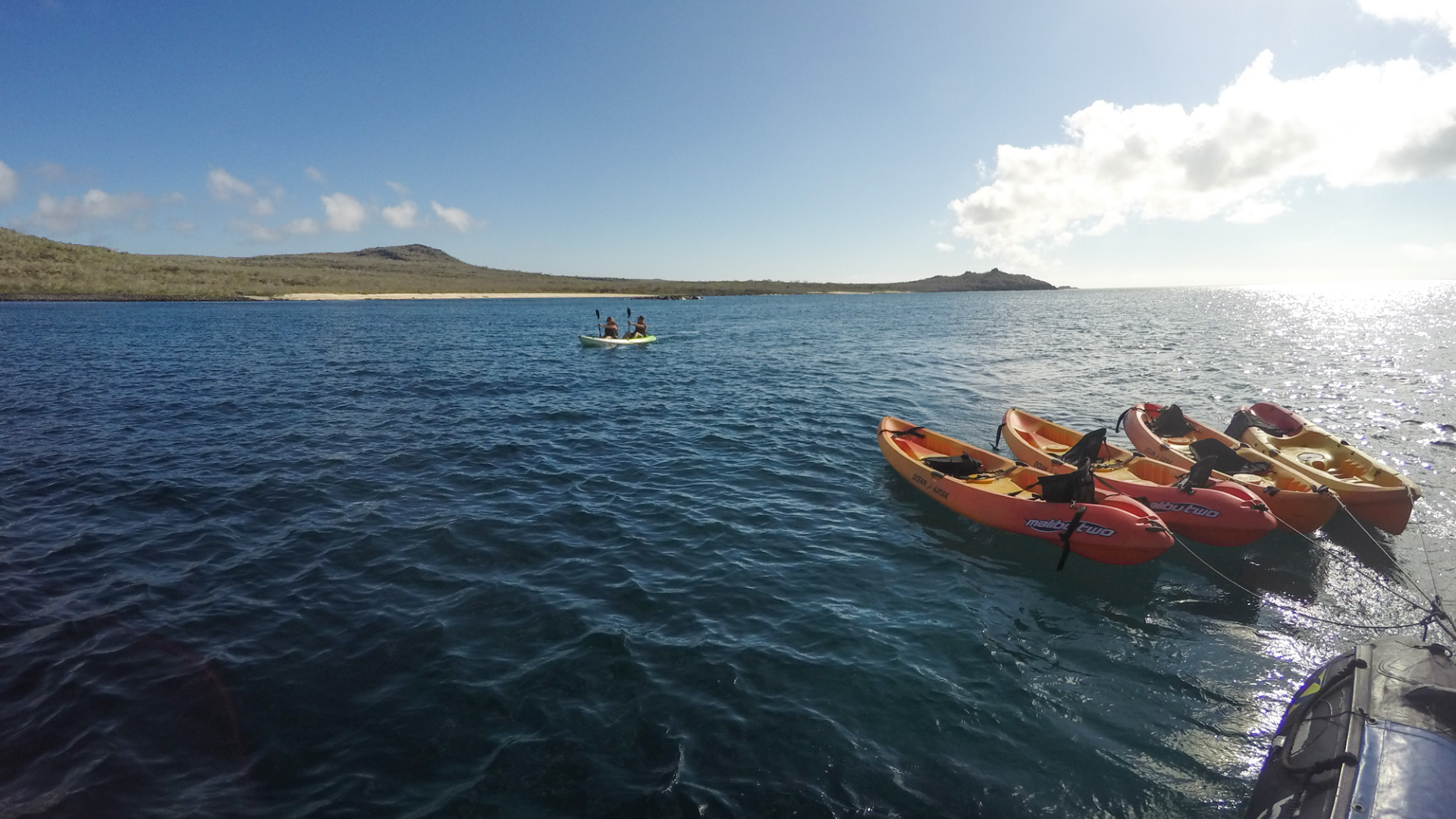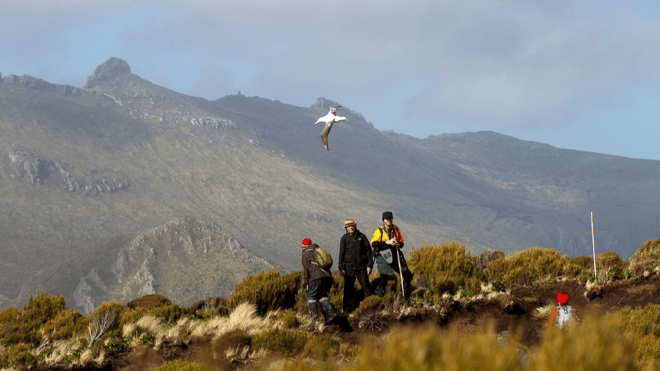Galapagos Islands: Luxury Expedition Cruise
The Galápagos Islands is a volcanic archipelago in the Pacific Ocean. It's considered one of the world's foremost destinations for wildlife-viewing. A province of Ecuador, it lies about 1,000km off its coast. Its isolated terrain shelters a diversity of plant and animal species, many found nowhere else. Silver Origin’s footprint is minimal, ensuring that this pristine environment remains intact. Her dynamic positioning system, which keeps her stationary without dropping anchor, protects the delicate seabed and protects the islands for many generations to come. And thanks to a new hull design and advanced propulsion system, Silver Origin meets or exceeds the highest standards of energy efficiency.
Destinations
San Cristóbal, Galapagos | Kicker Rock | Prince Philips Step's, Genovesa | Darwin Bay, Genovesa | North Seymour | Sullivan Bay (Santiago) | Bolivar Canal Cruising | Punta Mangle, Fernandina | Punta Moreno, Isabela | Santa Cruz Highlands | Fausto Llerena Breeding Center, Puerto Ayora (Santa Cruz) | Gardner Bay, Española | Punta Suarez, Española | San Cristobal, Isla lobos | Cerro Brujo, San Cristóbal | San Cristóbal, Galapagos
Ship - Silver Origin
Silversea's first destination-specific ship, is the height of experiential travel in the Galapagos. Never before have the islands been so superbly presented: a team of Ecuadorian national expert guides, the highest crew-to-guest ratio in the Galapagos, 8 Zodiacs, and seamless hybrid spaces that offer an extraordinary voyage – for extraordinary people. All-suite accommodation, Horizon Balconies, butler service, sophisticated interiors, interactive basecamp, Ecuadorian-inspired cuisine … no aspect of Silver Origin has been left to chance.
- Private executive transfers from home*
- Economy Class flights (baggage not included)*
- Airport Transfers
- Pre hotel stay (subject to flight schedule)
- 7 nights accommodation onboard Silver Origin
- All inclusive food and beverages whilst cruising
- Shore Excursions
- Expedition gear*
- Butler service in every suite
- Unlimited free Wi-Fi
- Personalised service – nearly one crew member for every guest
- Choice of restaurants, diverse cuisine, open-seating dining
- Beverages in-suite and throughout the ship, including champagne, select wines and spirits
- In-suite dining and room service
- Onboard entertainment
- Onboard gratuities
Your fare excludes:
- Tavel Insurance
Day 1: San Cristóbal, Galapagos
Like so many of the islands in the Galapagos, San Cristobal is formed by dormant volcanoes. It lies to the east of the archipelago and is one of the oldest islands in the group. Approximately 8,000 people live on the island, making their living from tourism, fishing, in government offices, or off the rich volcanic soils with some limited farming existing in the highlands. Puerto Baquerizo Moreno on the southwestern tip of the island is the capital city of the Galapagos Islands. A statue of Charles Darwin graces the harbor, marking one of the first places he likely stepped ashore in the 1830s.
Kicker Rock: Kicker Rock is the vertical remnant of a former tuff cone less than 5 kilometers to the west of San Cristobal. Both its Spanish name “Leon Dormido” (Sleeping Lion) and English name Kicker Rock imply that it is one rock only -when in fact it is a larger one 300 meters long by 100 meters wide with a maximum height of approximately 150 meters and next to it an obelisk-like rock separated by a narrow channel some 20 meters deep. When approaching Kicker Rock, Blue-footed Boobies, Nazca Boobies and frigatebirds can be observed in the air, while sea lions can be seen along the shore. Snorkelers and divers have reported manta rays, hammerhead sharks and turtles. The Spanish name implies that the geological formation seen from the south resembles a sleeping lion. An interesting explanation for the English name suggests that James Colnett in 1794 likened it to famous landmarks in Portsmouth.
Day 2: Darwin Bay, Genovesa
At Genovesa Island the ship tucks into Darwin Bay, an ancient volcanic crater now flooded by the sea. Zodiacs land on a picturesque sandy beach where Galapagos sea lions often rest on the fine, white sand. Explorations along the shore may reveal marine iguanas looking like prehistoric dinosaurs in miniature. By heading inland a short distance visitors could encounter seabirds of all shapes and sizes nesting in the vegetation. Scores of immature Red-footed Boobies perch on branches within an arm’s reach of the path. In addition, watch for Great Frigatebirds and Yellow-crowned Night Herons along the walk. There is also fantastic snorkeling in the waters of Darwin Bay with the opportunity to see large schools of reef fish and brightly colored sea stars.
Prince Philips Step's, Genovesa: Genovesa is one of the northernmost islands of the archipelago. Genovesa’s southern side of the shield volcano’s crater collapsed and a protected bay known as Darwin Bay was formed. The island is often referred to as the “Bird Island” as the numbers and species of land and seabirds on Genovesa are quite extraordinary. There are two visitor sites, and Prince Philip’s Steps give access to the flat plateau above the bay. Named after Prince Philip who visited the Galapagos on two occasions, the “steps” are mostly natural. The steep cliffs are home to Red-billed Tropicbirds, while Magnificent Frigatebirds, Nazca and Red-footed Boobies prefer the top. The plateau above Prince Philip’s Steps has a palo santo forest and an extensive lava field. This is an area where one of the Galapagos’ top predators, the Short-eared Owl, is hunting storm petrels. The Short-eared Owls are extremely well camouflaged and are not always easy to spot in between the rocks.
Day 3: North Seymour
The landing at North Seymour Island is onto black lava rock. After a short climb, visitors arrive on the island’s flat plateau where a number of sea lions nurse pups and frigatebirds nest. The island is dry, and so the predominant tree is the prickly pear cactus favored by the Galapagos land iguanas that live here in number. The undulating terrain is littered with red-brown volcanic boulders and large male Magnificent Frigatebirds can be seen inflating their vivid red gular sacs in hopes of impressing females flying overhead. At certain times of the year, pairs of Blue-footed Boobies dance here in a ritualized mating dance that reinforces their pair bond and shows off their vivid blue feet. The snorkeling here is well-known for schools of colorful creole wrasses and parrot fish.
Sullivan Bay (Santiago): The lava fields of Sullivan Bay on Santiago Island will inevitably remind visitors of the surface of the moon. As brilliant red Sally Lightfoot crabs scuttle along the black volcanic shores, learn about the formation of the islands through geological forces from your guides. The lava flows here are just over one hundred years old and date back to 1897. The lava took on a rope-like appearance and geologists have adopted a Hawaiian word, pahoehoe, as the technical name for this kind of volcanic rock.
Day 4: Bolivar Canal Cruising & Punta Mangle, Fernandina
Among the impressive new lava fields of Fernandina Island hides a cove surrounded by mangroves. A rewarding place for bird-watching as the bay is the point where the land meets the sea, joining the two environments, with sea birds, shorebirds and land birds all in the same place. The different species of mangroves: Red, White and Black, have formed a root system that serves as a nursery for many species of fish, including juveniles’ sharks and green sea turtles. Snorkeling is as rewarding with some unique sightings as Marine Iguanas feeding on algae, or flightless cormorants diving for their prey.
Punta Moreno, Isabela: This impressive and vast Pahoehoe black lava field is located on the south coast of Isabella Island and lies between two soaring active volcanoes, Sierra Negra and Cerro Azul, which you have a panoramic view of in the distance. Hike over huge other-worldly landscapes of corrugated lava which have been there for millennia. You can picture the lakes of hot lava as they poured from the mouth of the volcanoes now frozen in time. The rich blue waters of Cromwell Current wash the shores, and as a result, you can see the largest Marine Iguanas of the archipelago basking on the rocks. Watch Flightless Cormorants and Galapagos Penguins diving for food. Other wildlife to be found here includes Great blue Herons, White tipped Reef Sharks and look out for pelicans who nest in the emerald mangrove forest near the coastal lagoon.
Day 5: Santa Cruz Highlands
Santa Cruz Island reaches a maximum altitude of 864 meters (2,835 ft) above sea level; at high altitudes, weather changes creating microclimates. The species of flora and fauna found near the shoreline are extremely different from those on the highlands. Life in the highlands is much easier due to the presence of fresh water, from the constant drizzle that happens during the dry season to heavy rains that occur during the wet season. Local people take advantage of this climate to cultivate a large number of crops and giant tortoises love this ideal weather to mate, feed and rest before their next long migration to the shorelines.
Fausto Llerena Breeding Center, Puerto Ayora (Santa Cruz): Silver Origin will anchor in front of Puerto Ayora, Santa Cruz, where the prestigious Charles Darwin Research Station is located. The station also houses the Fausto Llerena Breeding Center for giant tortoises and land iguanas where guides interpret the centre’s captive breeding and reintroduction programs. In addition to these star species, throughout the station there are huge prickly pear cactus trees being fed upon by the pretty Galapagos Cactus Finch. To round out the stay in Puerto Ayora, enjoy free time in town where local artists have created charming art galleries and corner cafés.
Day 6: Gardner Bay, Española
Located on the northern coast of Española, the turquoise colour water and white sandy beach stand out from far away. This beach is made out of pulverised shells and corals offers a sandy patch of up to 1 kilometre in length. Española is considered one of the oldest in the Galapagos and has thus developed species that are endemic. Along the coast of Gardner a subspecies of colourful Marine iguanas are living among Hood Mockingbirds. The apex predators Galapagos Hawks commonly visit the coastline and a couple of times a Giant tortoise has been seen here.
Punta Suarez, Española: Punta Suárez lies at the western point of Española, the oldest island in the Galápagos. Sheer cliffs provide superb thermals for seabirds and you may spot Swallow-tailed Gulls, Nazca Boobies and Blue-footed Boobies on the breeze. The largest seabird to nest in the Galapagos Islands is the Waved Albatross. These ocean wanderers can be seen seasonally here from April through December, when pairs reunite on Española, going through an elaborate pair-bonding display. Mockingbirds, doves, and occasional Galápagos Hawks can also be seen on the point, along with sea lions and colorful marine iguanas.
Day 7: San Cristobal, Isla lobos & Cerro Brujo, San Cristóbal
An impressive tuff cone has been carved by erosion into an outstanding natural sculpture, being a resting place for marine birds such as blue-footed bobbies and brown pelicans. One of the most beautiful white sand beaches of the Galapagos (swim or snorkel). View sea lions, sally light footed crabs, blue-footed bobbies. Behind the dunes, you find a coastal lagoon, which was visited in the past by the locals to extract salt, today it is home to some shorebirds such as stilts and plovers.
Day 8: San Cristóbal, Galapagos
Like so many of the islands in the Galapagos, San Cristobal is formed by dormant volcanoes. It lies to the east of the archipelago and is one of the oldest islands in the group. Approximately 8,000 people live on the island, making their living from tourism, fishing, in government offices, or off the rich volcanic soils with some limited farming existing in the highlands. Puerto Baquerizo Moreno on the southwestern tip of the island is the capital city of the Galapagos Islands. A statue of Charles Darwin graces the harbor, marking one of the first places he likely stepped ashore in the 1830s.
Please Note: The excursions are provided as a sample of what may be offered on this voyage and are subject to change. We are constantly updating our shore excursion programme with immersive and authentic experiences, so please do not hesitate to review your tour programme choice closer to your sail date.
Travel between 12 - 19 October 2024 - Door to Door
- Classic Veranda Suite from
$19,800$17,300 per person twin share* - Superior Veranda Suite from
$20,300$17,800 per person twin share* - Deluxe Veranda Suite from
$21,000$18,500 per person twin share* - Silver Suite from
$28,200$25,700 per person twin share* - Royal Suite from
$33,500$31,000 per person twin share* - Owner's Suite from
$47,300$44,800 per person twin share*
Call our Australian travel team today on 1300 414 198 to book this once-in-a-lifetime experience.
*Please note that prices are valid to 31 August 2024, subject to availability at time of booking and may change without notice.
SUITES
Silversea's ocean view suites are some of the most spacious in luxury cruising. All include the services of a butler thanks to the highest service ratio at sea and almost all have a private teak veranda so that you can breathe in the fresh sea air by merely stepping outside your door.
Features in all suites: separate shower, walk-in wardrobe with personal safe, unlimited standard Wi-Fi, flat screen TV with Interactive Media Library, direct dial phone, wall mounted USB-C mobile device charger, butler service, champagne on arrival, pillow menu, refrigerator and bar setup stocked with your preferences, bathrobe and slippers, luxury bath amenities, umbrella, hair dryer.
Classic Veranda Suite
Stylish and sophisticated, the Classic Veranda is a haven of peace at the end of a busy day of discovery. A private veranda brings your destination even closer to home. Full butler service completes this suite.
Superior Veranda Suite
Designed to give you immersion far beyond excursion in the Galapagos. The unique Horizon Balcony converts your suite at the touch of a button, transforming your balcony into inside seating area. A large bathroom with window into the suite makes this an enviable option when choosing your Galapagos cruise.
Medallion Suite
Designed with the adventurous guest in mind, enlarge your suite at the touch of the button with the unique Horizon Balcony. The perfect hybrid of expedition and luxury, this suite features rich furnishings for easy-going comfort. An ocean view walk in shower extends your adventure even further.
Silver Suite
Enormous floor-to-ceiling windows look out onto the beauty of the ocean and its inhabitants. An ocean-view whirlpool bath allows you to experience the beauty of the islands, while enjoying the creature comforts of Silversea. Deluxe furnishings complete the experience.
Deluxe Veranda Suite
An ocean view walk-in shower plus the unique Horizon Balcony makes this the people’s choice when it comes to sailing the Galapagos Islands. Expertly designed and exquisitely appointed, Deluxe Veranda Suites are warm, spacious and elegantly designed, so that you can make the most of your adventure, without missing the comforts of home.
Grand Suite
affords superb views from morning to night thanks to a glass-panelled wall in the living area. A large, private veranda and ocean-view bathroom makes the most of the destination. Beautifully furnished and appointed, the Grand Suite is the perfect answer for those who like to explore in luxury.
Owner's Suite
Truly the apex of luxury for those who want to experience the islands in comfort. A separate bedroom, modern bathroom with whirlpool bath with ocean views and elegant seating area ensure privacy and cosiness are the name of the game, while the vast veranda means full island immersion is assured.
Travel at 60 and supplier booking conditions apply.
“Door-to-Door All-Inclusive Fares”
All fares are available in AUD, per guest, based on double-occupancy and include: “Air Programme”, “Shore Excursions Programme”, “Private Executive Transfers Service”, the “Expedition Package” (on Expedition Cruises only) and the “Fare Guarantee” policy - for additional details, please check the specific paragraphs below. Cruise fares also cover certain shipboard services including: suite accommodations, butler service in any suite, unlimited Wi-Fi, onboard meals and entertainment, 24-hour dining service, beverages aboard ship including select wines, champagnes, spirits, soft drinks, water, tea and coffee, gratuities aboard ship (except spa). Single supplements will apply and vary by voyage. To reserve a suite under this offer, a reduced deposit of 15% of the booking value is required within seven days of booking or sooner, depending on voyage and time of booking. Full payment is due no later than 120 days prior to departure otherwise, booking may be subject to immediate cancellation and any applicable penalties applied. Offer combinable with Venetian Society loyalty rewards.
Not included in your cruise fare are: selected shore excursions, meals ashore, fuel surcharges, dinners in La Dame, Seishin Restaurant and Kaiseki Restaurant, accommodations whilst ashore, casino gaming, laundry or valet services, purchases from the ship boutiques or any item or service of a personal nature such as medical care, massages, spa treatments, private fitness instruction, hair styling and manicures. Some champagne, premium wine and spirit selections, caviar, cigarettes and cigars are not included in your fare and may not be available at all times. Champagne and caviar are not offered onboard Silver Origin.
“Door-to-Door All-Inclusive Fares” penalty schedule
- 150-121 days prior to the initial sailing date: 15% of the total cruise fare per person;
- 120 – 91 days prior to the initial sailing date: 25% of the total cruise fare per person;
- 90 – 61 days prior to the initial sailing date: 50% of the total cruise fare per person;
- 60 – 31 days prior to the initial sailing date: 75% of the total cruise fare per person;
- 30 – 0 days prior to the initial sailing date or nonappearance at the time of sailing: 100% of the total cruise fare per person.
This holiday deal has expired.
Want to find an alternative? Search for another holiday here or contact us.




